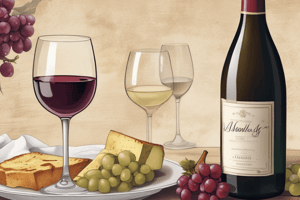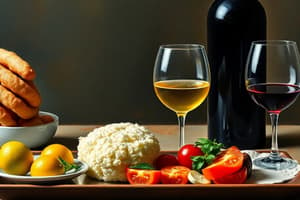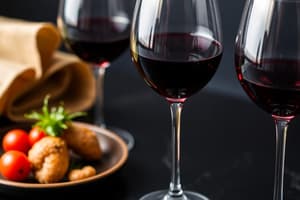Podcast
Questions and Answers
What health risk is NOT associated with excessive drinking?
What health risk is NOT associated with excessive drinking?
- Alcohol dependence
- Cirrhosis of the liver
- Improved metabolism (correct)
- Cardiac arrest
How does sweetness in food affect the perception of wine?
How does sweetness in food affect the perception of wine?
- Increases perception of sweetness and fruitiness
- No effect on wine perception
- Decreases perception of body and sweetness (correct)
- Decreases perception of bitterness and acidity
Which food component makes wines taste 'harder'?
Which food component makes wines taste 'harder'?
- Salt
- Bitterness
- Umami
- Sweetness (correct)
Which of the following best describes the main purpose of food and wine pairing?
Which of the following best describes the main purpose of food and wine pairing?
What effect do foods like chocolate have when tasting wine?
What effect do foods like chocolate have when tasting wine?
What factor is more likely to negatively impact the taste of wine during pairing?
What factor is more likely to negatively impact the taste of wine during pairing?
Which health risk is directly connected to consistent heavy drinking?
Which health risk is directly connected to consistent heavy drinking?
What is a key consideration when selecting wine for dishes containing sugar?
What is a key consideration when selecting wine for dishes containing sugar?
What effect does umami have on the perception of sweetness in wine?
What effect does umami have on the perception of sweetness in wine?
Which food is considered difficult to pair with wine due to its high level of umami without salt?
Which food is considered difficult to pair with wine due to its high level of umami without salt?
How does acidity in food generally affect the perception of wine?
How does acidity in food generally affect the perception of wine?
What impact does salt have on the perception of bitterness in wine?
What impact does salt have on the perception of bitterness in wine?
What happens to the perception of wine when food with high acidity is paired with a low acidity wine?
What happens to the perception of wine when food with high acidity is paired with a low acidity wine?
Which taste does umami strongly interact with in food to enhance its flavor?
Which taste does umami strongly interact with in food to enhance its flavor?
What effect does bitterness in food have on wine?
What effect does bitterness in food have on wine?
How can one best experience umami in mushrooms?
How can one best experience umami in mushrooms?
How many 175 mL glasses can you get from a standard 75 CL bottle of wine?
How many 175 mL glasses can you get from a standard 75 CL bottle of wine?
Which wine preservation method utilizes the removal of oxygen from the bottle?
Which wine preservation method utilizes the removal of oxygen from the bottle?
What is the recommended maximum number of units of alcohol a woman should consume daily on average?
What is the recommended maximum number of units of alcohol a woman should consume daily on average?
What should one avoid when drinking alcohol, according to sensible drinking guidelines?
What should one avoid when drinking alcohol, according to sensible drinking guidelines?
What is a potential consequence of consuming alcohol faster than one standard drink per hour?
What is a potential consequence of consuming alcohol faster than one standard drink per hour?
What does a blanket system do to protect wine from air?
What does a blanket system do to protect wine from air?
What is one of the risks associated with drinking alcohol to the point of drunkenness?
What is one of the risks associated with drinking alcohol to the point of drunkenness?
What is the threshold of alcohol units for men to consume daily on average?
What is the threshold of alcohol units for men to consume daily on average?
What is the first step in opening a bottle of light wine?
What is the first step in opening a bottle of light wine?
Why is it important to chill sparkling wine before opening?
Why is it important to chill sparkling wine before opening?
What should you do immediately after loosening the wire cage on a sparkling wine bottle?
What should you do immediately after loosening the wire cage on a sparkling wine bottle?
What indicates that wine may be spoiled when checking its appearance?
What indicates that wine may be spoiled when checking its appearance?
How should you properly release the cork from a sparkling wine bottle?
How should you properly release the cork from a sparkling wine bottle?
What should you look for in the aroma of wine when serving?
What should you look for in the aroma of wine when serving?
What is a crucial consideration when serving wine by the glass?
What is a crucial consideration when serving wine by the glass?
What should be checked to determine the freshness of wine before serving?
What should be checked to determine the freshness of wine before serving?
Flashcards
Opening a Bottle of Wine
Opening a Bottle of Wine
The process of removing the cork from a bottle of wine using a corkscrew.
Serving Wine by the Glass
Serving Wine by the Glass
The act of serving wine into a glass, ensuring it's clear, fresh and poured in the correct measure.
Capsule
Capsule
A protective cover around the top of a wine bottle, usually made of metal.
Removing the Foil
Removing the Foil
Signup and view all the flashcards
Drawing the Cork
Drawing the Cork
Signup and view all the flashcards
Loosening the Wire Cage
Loosening the Wire Cage
Signup and view all the flashcards
Turning the Bottle
Turning the Bottle
Signup and view all the flashcards
Sparkling Wine
Sparkling Wine
Signup and view all the flashcards
Serving Sizes From a Wine Bottle
Serving Sizes From a Wine Bottle
Signup and view all the flashcards
Vacuum Wine Preservation System
Vacuum Wine Preservation System
Signup and view all the flashcards
Blanket Wine Preservation System
Blanket Wine Preservation System
Signup and view all the flashcards
Legal Drinking Age (LDA)
Legal Drinking Age (LDA)
Signup and view all the flashcards
Blood Alcohol Concentration (BAC)
Blood Alcohol Concentration (BAC)
Signup and view all the flashcards
Sensible Drinking Guidelines
Sensible Drinking Guidelines
Signup and view all the flashcards
Drinking to Drunkenness
Drinking to Drunkenness
Signup and view all the flashcards
Drunkenness
Drunkenness
Signup and view all the flashcards
Health Risks of Excess Drinking
Health Risks of Excess Drinking
Signup and view all the flashcards
Food and Wine Pairing
Food and Wine Pairing
Signup and view all the flashcards
Taste Adaptation
Taste Adaptation
Signup and view all the flashcards
Mouthcoating Effect
Mouthcoating Effect
Signup and view all the flashcards
Food Components Affecting Wine Taste: 'Harder' Wine
Food Components Affecting Wine Taste: 'Harder' Wine
Signup and view all the flashcards
Food Components Affecting Wine Taste: 'Softer' Wine
Food Components Affecting Wine Taste: 'Softer' Wine
Signup and view all the flashcards
Food Dominates Wine Taste
Food Dominates Wine Taste
Signup and view all the flashcards
Sugar's Effect on Wine Taste
Sugar's Effect on Wine Taste
Signup and view all the flashcards
Umami's Effect on Wine
Umami's Effect on Wine
Signup and view all the flashcards
Umami's Effect on Wine (no salt)
Umami's Effect on Wine (no salt)
Signup and view all the flashcards
Acidity's Effect on Wine
Acidity's Effect on Wine
Signup and view all the flashcards
Salt's Effect on Wine
Salt's Effect on Wine
Signup and view all the flashcards
Bitterness' Effect on Wine
Bitterness' Effect on Wine
Signup and view all the flashcards
Umami and Salt in Food
Umami and Salt in Food
Signup and view all the flashcards
Individual Sensitivity to Bitterness
Individual Sensitivity to Bitterness
Signup and view all the flashcards
Harmony in Food and Wine Pairing
Harmony in Food and Wine Pairing
Signup and view all the flashcards
Study Notes
Chapter Five: Wine Spirits & Cigars
- Chapter five covers wine spirits and cigars.
Opening a Bottle of Light Wine
- Remove the capsule by cutting below the bottle lip.
- A capsule remover or knife can be used.
- Clean the bottle neck with a clean cloth.
- Gently insert and use a corkscrew to remove the cork.
- Clean the bottle neck thoroughly.
How to Open a Bottle of Sparkling Wine
- Danger: Sparkling wine has considerable pressure.
- Chilling reduces pressure and helps prevent cork explosion.
- Use a linen cloth to cover the cork and bottle.
- Remove the foil and loosen the wire cage. Don't remove the wire cage.
- Securely hold the cork while using the other hand to grip the base of the bottle.
- Tilt the bottle at approximately 30 degrees.
- Slowly remove the cork, easing it out of the bottle, while resisting any tendency for it to fly out.
- Gas pressure should be released with a quiet "phut" sound.
Serving Wine by the Glass
- Wine should be bright, without any dullness.
- No debris should float in the wine.
- The wine's aroma should be fresh.
- Wine that has been exposed to air for too long can be dull and lack flavour.
- Check the wine's nose (aroma) and ensure it's not unpleasant.
Serving Wine by the Glass: Measurements
- 75 cl bottle yields:
- 6 x 125 ml glasses
- 4 x 175 ml glasses
- 3 x 250 ml glasses
Methods Used to Preserve Wine
- Keep opened wine properly stored to extend its life and to prevent wastage.
- Many wines kept for serving glasses are refrigerated, without any added protection.
- Vacuum systems remove oxygen from the bottle and seal it.
- Blanket systems blanket wine with gas heavier than oxygen.
Social Responsibility
- Alcohol enjoyment should be in moderation.
- Most countries have legislation regulating excessive alcohol consumption.
- Legal drinking age and blood alcohol concentration (BAC) are key factors.
- Sensible drinking guidelines include one or two alcohol-free days per week.
- Preventing serving a drunken customer is critical.
Standard Drinks
- Women should limit daily alcohol intake to two units.
- Men should limit daily alcohol intake to three units.
Drinking to Drunkenness
- Consuming alcohol rapidly causes it to flood the brain.
- Interference with brain functions can impair judgement and increase risky behaviour.
- Risks involved include injuries, unsafe sex, arguments, relationship problems, alcoholic poisoning, coma, brain damage, or death
Health Risks of Excessive Drinking
- Habitual excessive drinking raises risks of:
- Alcohol dependency/alcoholism
- Liver cirrhosis or alcoholic fatty liver
- Cardiac arrest and stroke
- Stomach disorders (e.g., ulcers)
- Certain types of cancer
- Family and job-related difficulties.
Introduction to Food and Wine Pairing
- Food consumed with wine impacts taste perception.
- Wine pairing enhances the tasting experience from food and wine.
- Understanding wine-food pairings avoids unpleasant interactions.
- People have differing sensitivities to flavour and aroma.
Primary Food and Wine Taste Interactions
-
Taste perception changes based on the order of consumption.
-
Thick creamy food can impair the sense of taste.
-
Food and wine components (sweetness, salt, acidity) impact taste differently.
-
Generally, the impact of food is more pronounced on wine than vice versa..
Primary Food and Wine Taste Interactions: Sweetness in Food
- Sweetness heightens or decreases the perception of other tastes.
- Sweetness in food may mask the perception of bitterness, acidity, and alcohol.
Primary Food and Wine Taste Interactions: Umami in Food
- Umami (savory taste) is often enhanced or masked in combination with other tastes.
Primary Food and Wine Taste Interactions: Acidity in Food
- Acidity in food generally has a positive effect.
- Acidity in food can balance high-acid wine and enhance fruitiness.
Primary Food and Wine Taste Interactions: Salt in Food
- Salt affects bitterness and acidity perception.
- Salt softens intense wine tastes.
Primary Food and Wine Taste Interactions: Bitterness in Food
- Bitterness levels affect wine taste perception.
- Bitterness in food can sometimes combine with wine bitterness to produce unpleasant levels..
Primary Food and Wine Taste Interactions: Chili Heat in Food
- Chili heat is a tactile sensation.
- Chili heat affects the perception of wine tastes.
- Chili heat intensifies with alcohol levels.
Studying That Suits You
Use AI to generate personalized quizzes and flashcards to suit your learning preferences.




